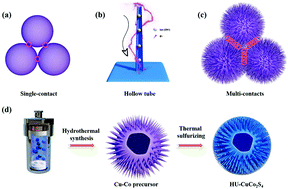Sea urchin-like CuCo2S4 microspheres with a controllable interior structure as advanced electrode materials for high-performance supercapacitors†
Abstract
The rational construction of a supercapacitor electrode structure that realizes high specific surface area, good cycling stability and high capacitance on a gravimetric basis is a basic concern but it is difficult to meet the commercial standards due to many fundamental challenges. Here, hierarchical CuCo2S4 microspheres, which possess urchin-like overall morphology, porous nanotubes and controlled inner structures, can be obtained from a hydrothermal process and a subsequent sulfurization process by changing the organic species during the hydrothermal process. Benefiting from the hollow urchin structure, the hollow urchin-like CuCo2S4 possesses a much-improved surface area to provide more active sites and maintain sufficient contact with the electrolyte. As a result, the hollow urchin-like CuCo2S4 exhibits a high specific capacitance of 1069 F g−1 at a current density of 1 A g−1, a high rate capacity of 61.2% retention and a good cycling stability of 93.7% retention after 10 000 cycles. Moreover, a hollow urchin-like CuCo2S4//activated carbon hybrid supercapacitor device is assembled, which shows a high energy density of 49.8 W h kg−1 at a power density of 4000 W kg−1, and an excellent cycling stability of 88% retention after 5000 cycles. This facile method for the fabrication of hierarchically designed electrode materials offers the possibility for high-performance supercapacitors.



 Please wait while we load your content...
Please wait while we load your content...